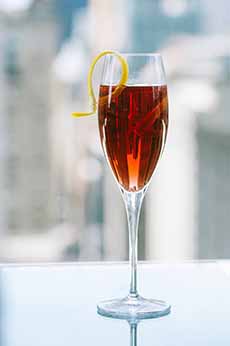
[1] Sherry, a fortified wine, can also be used in cocktails (photo © Davio’s | New York City).
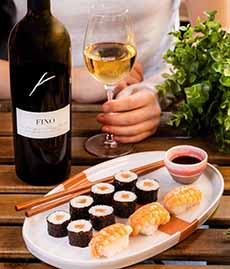
[2] Fino Sherry is delicious with seafood, cooked or raw (photos #2, #3, #5, #6, #7, #8 © Consejo Regulador de las Denominaciones de Origen “Jerez-Xérès-Sherry”).

[3] Some sherries pair beautifully with Japanese and Korean food.
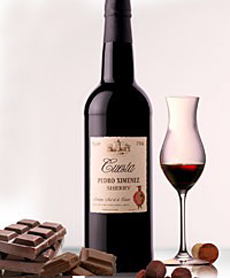
[4] Sweet Sherries are delicious with chocolate and dessert (photo © Bodega Jose De La Cuesta).
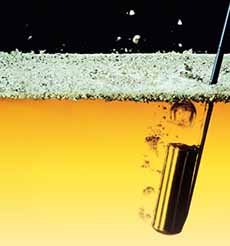
[5] Flor, the yeast layer atop Fino sherries.
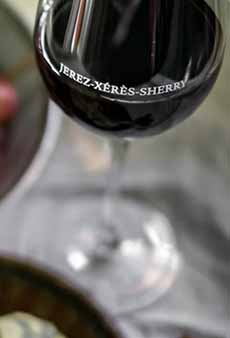
[6] While all Sherries are made from white grapes, sweet wines are darker and they can age until they look as dark as the deepest red wine (photo © ).
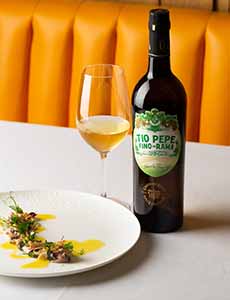
[7] A Fino Sherry with a seafood appetizer.

[8] Sherry can also be used for cocktails.
|
|
The first full week of November is International Sherry Week. When was the last time you had a glass of sherry? There’s no time like the present: Sherry Week, with tasting events worldwide, offers the opportunity to try different types of Sherry.
While Sherry has fallen out of fashion in recent decades, it was a palate-pleaser for centuries and you might want to take a look.
Sherry wine is a fortified wine from the Jerez-Xérès-Sherry region of Spain.
Fortified means that a distilled spirit is added to the base wine. This both increases its alcohol content and gives the wine a longer shelf life.
So think of sherry as a highly alcoholic wine. It can range from 15% to 22% ABV.
Why three names?
In the Spanish language, the wines are named after Jerez de la Frontera, a city in Andalusia, in southwestern Spain. But the French were also fond of the wine, which they spelled Xérès (phonetically similar to Jerez) and the Brits used the spelling Sherry.
The label of each bottle of sherry has the name in all three languages, as Jerez-Xérès-Sherry.
Sherry is often enjoyed as an apéritif or at the end of a meal, like Port, with the cheese course or dessert.
But in Spain, sherry is an after-work drink with tapas (here’s how to have a tapas cocktail party).
> How sherry is produced.
> The solera system of aging, unique to Sherry.
> The history of sherry is below.
> Sherry as an apéritif.
> A glossary of Sherry terms.
> Oloroso sherry for dessert and cheese.
> Dry sherry in a hot apple toddy.
> The year’s 25+ red wine holidays.
TYPES OF SHERRY
Sherry is made from three white grapes: Palomino, Pedro Ximénez, and Moscatel. Palomino is the most common; Moscatel and Pedro Ximenez are used to make swweet sherries. Here’s more about the grapes.
Most Sherries are vinified dry except for the sweet Cream Sherries. They range from 17% to 22% ABV (Alcohol By Volume).
> Here are food pairings and recipes for each type of sherry.
There are two basic types of Sherry: Fino and Oloroso, distinguished by production method. All other styles are variations of these two.
Fino Sherry, meaning “refined,” is made by biological aging under the action of a layer of flor yeast growing on the wine surface, known as the veil of flor (photo #5). The yeast converts sugars into ethanol, making the wine alcoholic. As the yeast converts sugar over time, the yeast cells die and float to the top of the barrel. These dead yeast cells are known as “flor” or “flor yeast.” The layer of flor creates a barrier for the Sherry, preventing it from being exposed to oxygen, or oxidation. Fino sherries taste of almonds and green olives. Here’s more about flor.)
Oloroso Sherry, meaning “scented” or “pungent,” is made by oxidative aging after fortification with ethanol. This avoids the growth of flor yeast. While oxidation can ruin certain types of wine, it is essential for the Oloroso style of Sherry. Oloroso Sherries are sweeter with flavors of figs, other dried fruit, maple syrup and roasted nuts.
Try both styles to see what your palate prefers.
Thanks to the Consejo Regulador de las Denominaciones de Origen “Jerez-Xérès-Sherry” flr much of this information.
DRY SHERRY WINES
Amontillado Sherry. This hybrid style made from palomino grapes begins as a Fino and is then fortified to a higher ABV, which kills the flor and makes it an Oloroso. Amontillado is a unique wine due to its dual aging process: It has the tangy quality of a Fino along with notes of dried fruit, roasted nuts, spice, and tobacco of an Oloroso. Amontillados may have hints of hazelnuts, cedar, and slight tones of honey. The wines are very complex. An amontillado may be dry, can, or have a bit of PX (Pedro Ximénez—see below) added for a touch of sweetness. On a personal note: We first heard of amontillado in grade school, in Edgar Allen Poe’s The Cask Of Amontillado. It’s a quick read to enjoy with a glass of the wine.
Fino Sherry is a dry white wine made from palomino grapes (photo #7). As with all varieties of Fino, it’s aged under the veil of flor. Fino is the classic dry Sherry, tangy and yeasty, with almond notes. Serve it as an apéritif with olives and nuts that complement its natural flavors, and add slices of serrano ham and chorizo or other Spanish sausage. Chilled, Fino is a good pairing with seafood, cooked and raw (including ceviche and sushi)—both as a glass of wine, and added to sauces (check out this Crab Newburg).
Manzanilla Sherry. Manzanilla, a Fino Sherry, is a dry white wine made from palomino grapes and aged under the veil of flor. A dry, delicate, and crisp Fino Sherry, Manzanilla is unique Fino in that it’s produced only in the seaside town of Sanlucar de Barrameda. The ocean terroir delivers a subtly salty, sea-spray quality and a floral tone said to be reminiscent of chamomile. In fact, manzanilla is the Spanish word for chamomile. Serve it well chilled and finish the bottle within a day or two.
Oloroso Sherry is made by oxidative aging, which gives it a dark color ranging from amber to mahogany, depending on length of aging. Oloroso wines are full-bodied, dense, and complex, with an intensely walnutty character and smooth texture. They also may be given a bit of PX (Pedro Ximénez—see below) for balance. The warm, rounded aromas are both complex and powerful. Oloroso is often served at the end of the meal with the cheese course (especially with hard cheeses).
Palo Cortado Sherry. This rare Sherry is called the “accidental” sherry. It begins its journey as a Fino under flor and is initially intended to stay a Fino or become an Amontillado. Then, for reasons that are not understood (but are the “happy accident”), it loses its flor before fortification and begins to evolve oxidatively like an Oloroso. Complex and sophisticated, it combines the delicate bouquet of an Amontillado with the body and flavor of an Oloroso. It can range from rich sweetness to crisp dryness.
SWEET SHERRY WINES
Cream Sherry is a semi-sweet wine made by sweetening an Oloroso to 11% or higher residual sugar. It is intended as an after-dinner drink or a dessert wine and can carry flavors of fig, chocolate, dried fruits, and roasted nuts. The Oloroso is blended with PX (Pedro Ximénez), a naturally sweet wine, so cream Sherry is commonly known as Sweet Oloroso. Ranging in color from chestnut brown to dark mahogany, the wine has a dense, syrupy texture.
Medium Cream Sherry is is usually sweetened Amontillado. According to the rules of the Denominación de Origen, any sherry with a sugar content of more than 5 grams per liter and up to 115 grams per liter is called “Medium.”
Pale Cream Sherry is a sweetened Fino.
NATURALLY SWEET SHERRY WINES
These two wines are naturally sweet, as a result of the particular grapes with which they are made. Both are dark in hue.
Moscatel Sherry. Moscatel is one of the three Sherry grapes. It has pronounced fruity notes and lots of aromatics. As with Manzanilla, the Moscatel vineyards are close to the beach in sandy soils. This gives the wine considerable “maritime influence” (sea-spray salty).
Pedro Ximénez Sherry, called PX for short, is a classic dessert wine, dark, intense, thick and syrupy with a rich nose and sweet flavors of dried fruits (raisins, figs and dates), honey, grape syrup, jam, and candied fruit (photo #6). The grapes are air dried on mats for a week or two, concentrating the sugars (up to 50% residual sugar). It is paired with dessert—you can pour it over ice cream— or drunk on its own. The story of the eponymous Pedro Ximénez is not entirely clear. Still, one story cites a Spanish soldier, Pedro Ximén, who picked up some vines in Germany and propagated them in Andalusia. Here’s the story.
OTHER SHERRY WINES
Sherries that have been aged for an especially long time are known as V.O.S. & V.O.R.S.
These include Sherries of Certified Age, Sherries With Indication Of Age, and Vintage Sherries. Here’s more about them.
|
NEXT STEPS
Perhaps a sherry-tasting party?
At the very least, buy a bottle of sherry vinegar!
Sherry vinegar has a distinct and delightful flavor. You can use it in just about any vinaigrette. Try it in a Dijon vinaigrette instead of red wine vinegar.
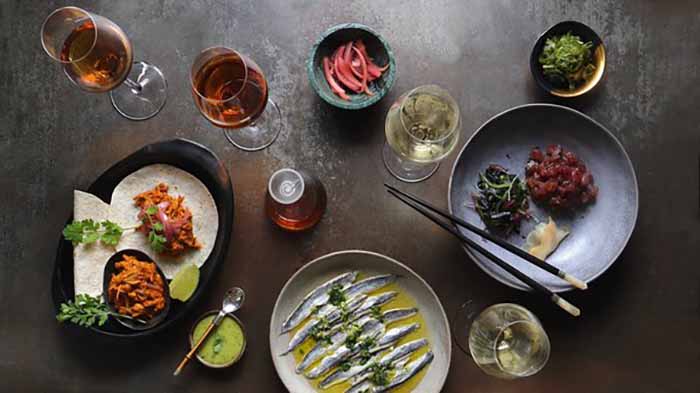
[9] Sherry with appetizers (photo © Consejo Regulador de las Denominaciones de Origen “Jerez-Xérès-Sherry” – “Manzanilla-Sanlúcar de Barrameda” – “Vinagre de Jerez”).
THE HISTORY OF SHERRY
Phoenicians, 1100 B.C.E.: Viticulture begins in what is today the Jerez region of Spain. The Phoenicians founded the city of Gadir (modern-day Cádiz, Spain) and brought grapevines and wine-making expertise with them.
Romans, 206 B.C.E.: The Romans conquered the area and exported the local wine throughout their empire. The wine was known as vinum ceretensis, wine from Ceret—the Roman name for Jerez. It was a primitive form of modern sherry. The Roman writer Martial noted that it was highly regarded in elite Roman circles.
Moors, 711 C.E.: The region became under the rule of the Moors of North Africa. They changed the name of Ceret to Sherish. Although the consumption of alcohol was generally forbidden among Islamic people, wine-making continued for trade and medicinal purposes.
Crucially, the Moors introduced the alembic (distillation) process, the precursor to the technique of fortifying the wine with grape spirit (today called brandy de Jerez).
Christian Reconquista, 1264: The Christians reconquered Jerez. The local wine industry soon thrived due to the proximity of the city to the major ports of Cádiz and Sanlúcar de Barrameda.
The Age Of Exploration, Early 15th-Early 17th Centuries:Sherry becomes the first global wine, an essential provision for long sea voyages during the Age of Exploration, as the addition of alcohol helped to preserve it. Christopher Columbus and Ferdinand Magellan both stocked sherry on their ships.
England & Sir Francis Drake, 1587): The English privateer (or pirate), Sir Francis Drake raided Cádiz and brought back around 3,000 barrels of sherry, or “sack,” the English name for the fortified wine. It became instantly fashionable in Elizabethan England.
Britain, 17th-18th Centuries: English, Scottish, and Irish merchants moved the Sherry region, establishing many of the famous bodegas (wineries) and helping to professionalize and expand the export trade.
Modern Era: Solera System: By the 18th and 19th centuries, the solera system of aging and blending was fully developed. This is a unique process of fractional blending that involves stacking barrels (called criaderas) in layers, with the oldest wine on the bottom (solera). A portion is drawn for bottling from the bottom, and the barrel is topped up with wine from the layer above. This system ensures consistency and allows the blend to contain traces of very old wine, giving sherry its unique, complex character.
The First Spanish D.O., 1933 To protect the wine’s identity, the Jerez region was formally established as the first Spanish Denominación de Origen (D.O.). This regulation ensured that only wine produced in the designated “Sherry Triangle” using the traditional methods could legally be called sherry (within the EU).
Sherry today: Sherry remains one of the world’s great fortified wines, ranging from the bone-dry Fino and Manzanilla to the rich, sweet Pedro Ximénez dessert wine. It is one of The Big Four traditional fortified wines, along with Madiera and Port from Portugal and Marsala from Italy.
Information from Gemini.
CHECK OUT WHAT’S HAPPENING ON OUR HOME PAGE, THENIBBLE.COM.
|











